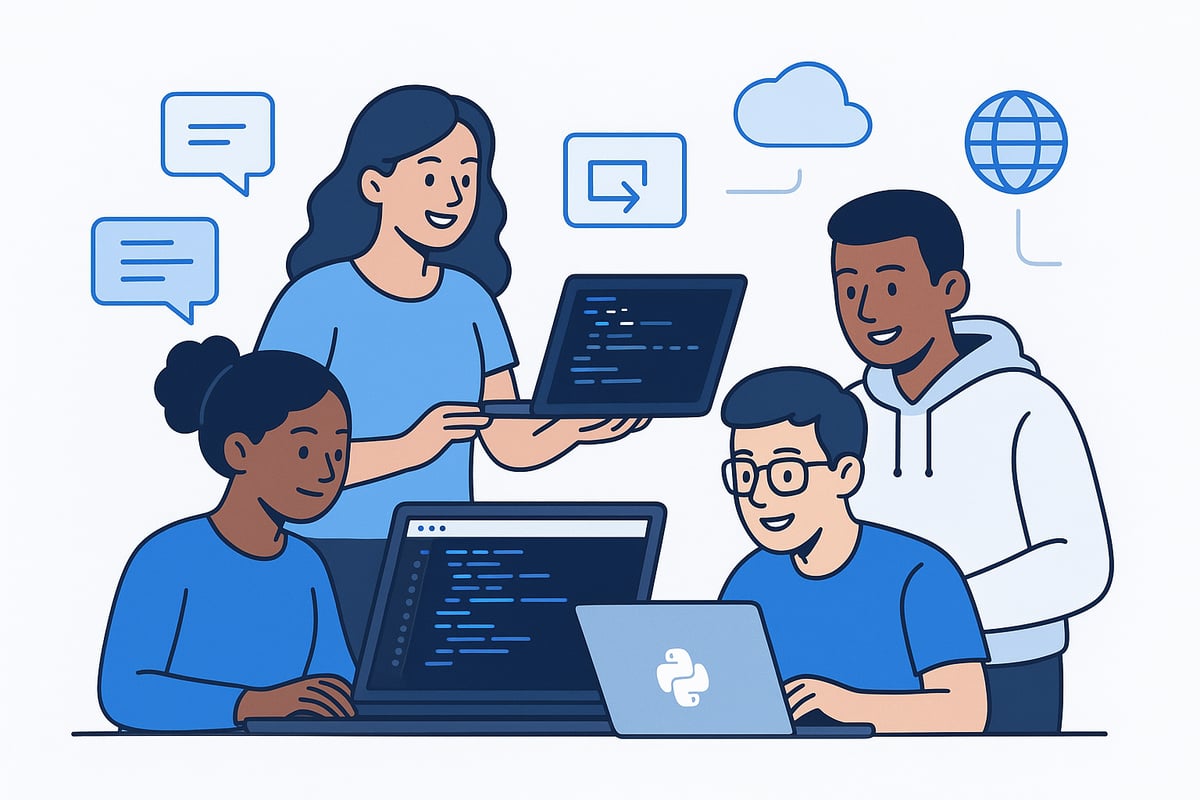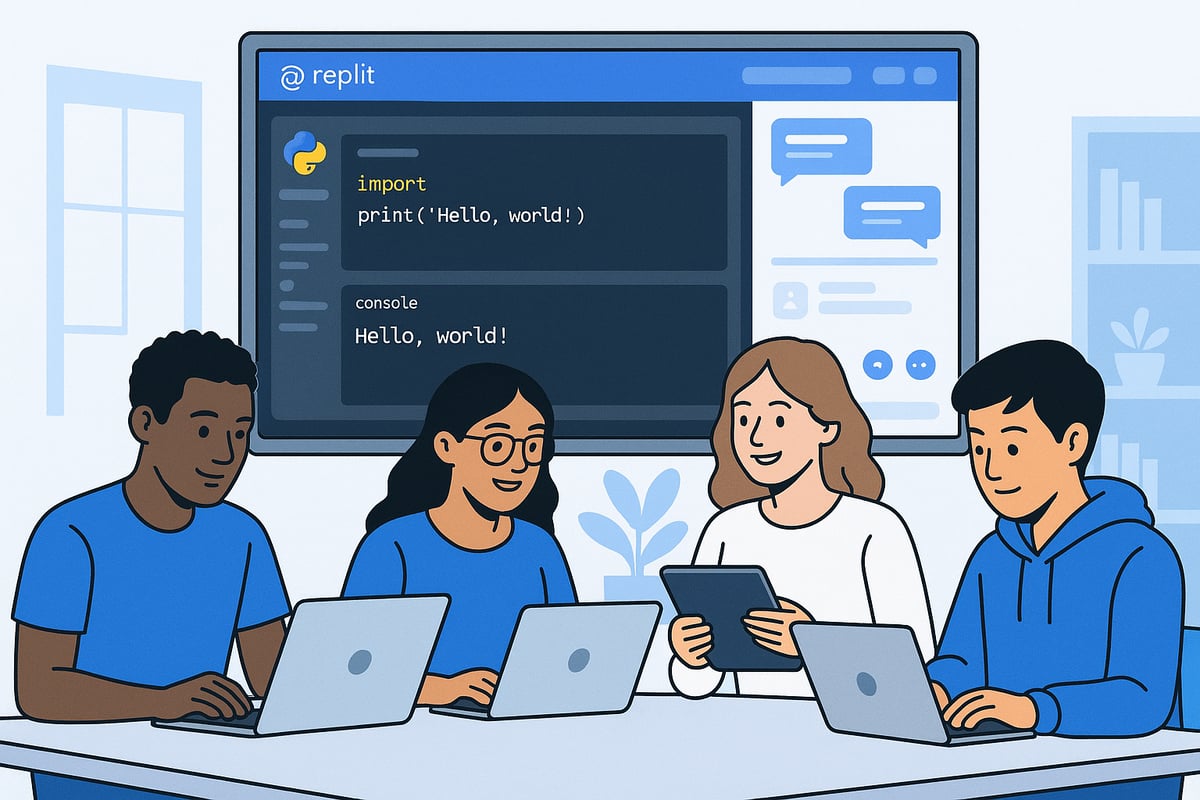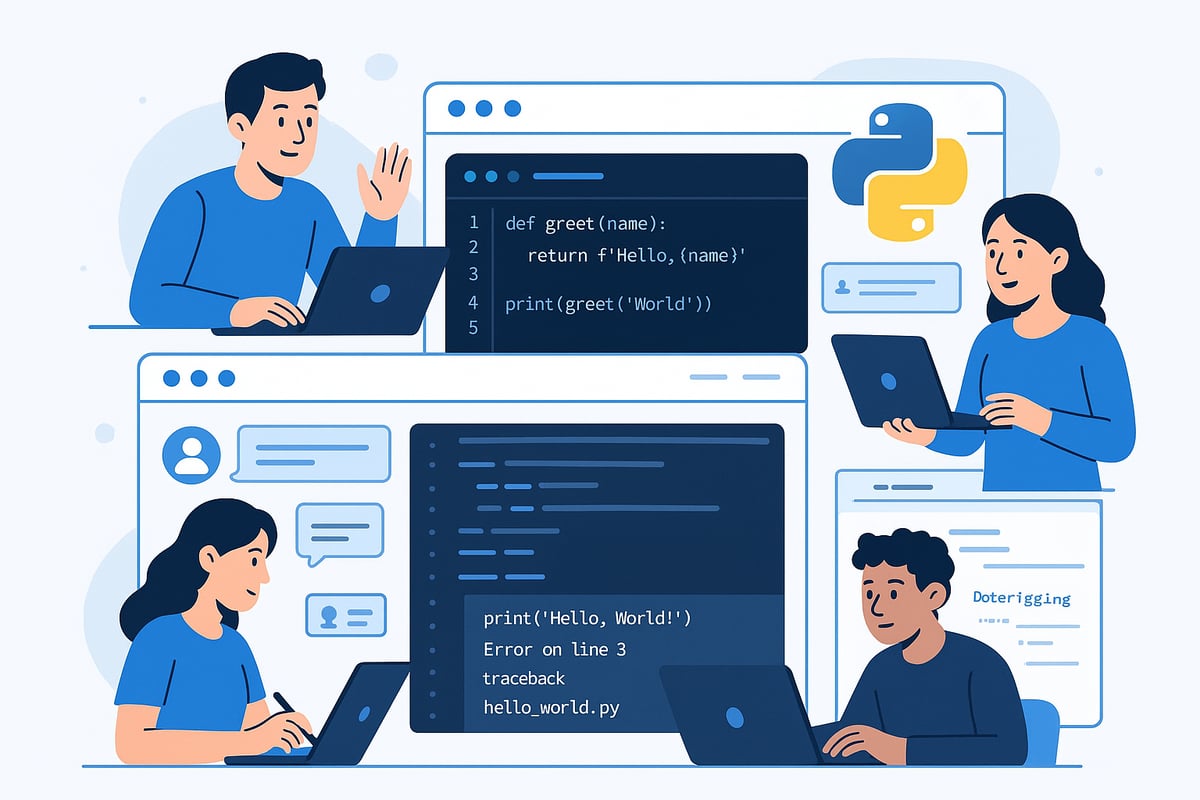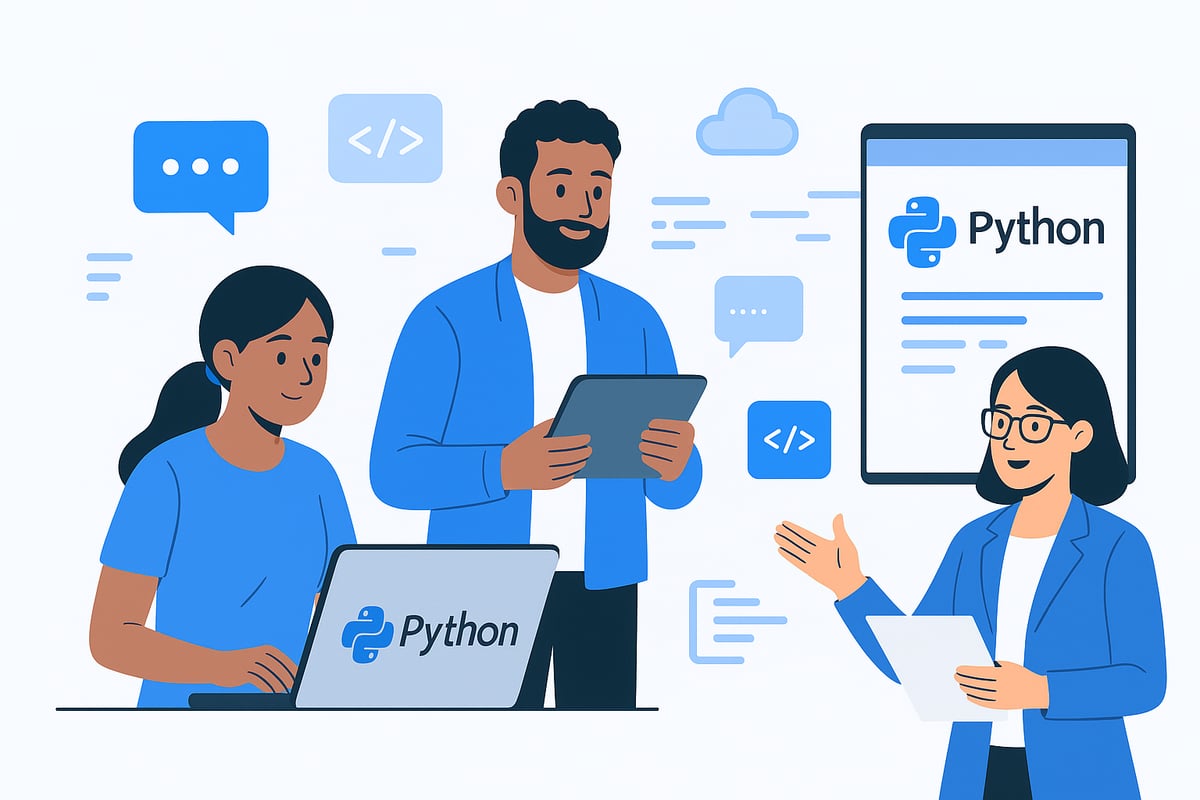Online Python learning is experiencing explosive growth in 2025, powered by a new wave of cloud-based coding platforms. Among these, replit python stands out for its seamless access, robust collaboration tools, and rapid deployment options.
Whether you are a beginner eager to write your first script or an advanced developer building complex applications, this guide is your roadmap to mastering replit python online. We will explore its core features, step-by-step setup, advanced productivity tips, and what the future holds for coding with Replit.
Ready to accelerate your Python journey? Dive in and unlock the full potential of replit python with this definitive guide.
What is Replit Python? An Overview for 2025
In 2025, the world of coding has shifted rapidly online. Developers and learners everywhere are flocking to platforms that make programming accessible, collaborative, and efficient. At the heart of this movement sits replit python, a cloud-based environment redefining how people code, learn, and build together.

The Evolution of Online Coding Platforms
The rise of cloud-based Integrated Development Environments (IDEs) has transformed coding for millions. By 2024, over 20 million users had adopted online coding platforms. Among them, replit python stands out as a top choice, offering seamless access from any device and browser.
Unlike traditional IDEs, replit python requires no local setup. Its popular "100 Days of Python" course helps learners worldwide get started quickly. Compared to other online platforms, Replit’s interface is intuitive and welcoming, making it a favorite for both solo learners and remote teams.
This surge in popularity is fueled by Replit's rapid growth and industry recognition, highlighted by Replit's $250 Million Funding Round, which cements its position as a leader in global coding education and remote work.
Core Features of Replit Python
What makes replit python so powerful? Its in-browser code editor provides syntax highlighting and auto-completion, making writing code smoother. With instant code execution and a real-time output console, you see results immediately.
- Project templates help you start fast, supporting multiple Python versions.
- The integrated package manager lets you add libraries like
numpyorrequestswith a click. - Built-in version control and Git integration keep your projects organized.
For example, you can prototype a new idea or learn a concept without any downloads. This flexibility makes replit python ideal for both quick experiments and serious projects.
| Feature | Benefit |
|---|---|
| Instant Execution | See code output immediately |
| Version Control | Track and revert changes |
| Templates | Quick project setup |
| Package Manager | Easy library installation |
Replit’s Collaborative Ecosystem
Collaboration is central to replit python. Its multiplayer mode allows real-time coding with friends or teammates. You can chat live, leave comments, and review code without switching tools.
Community-driven project sharing is another strength. Projects can be forked, making it easy to build upon others’ work. In 2024 alone, users shared and forked millions of Python projects, fueling a vibrant ecosystem.
For example, open-source web apps and games are often built collaboratively on replit python. The platform’s tools make teamwork feel natural, whether you are in a classroom or working remotely.
Why Replit is Ideal for Python in 2025
Replit python removes barriers for learners, educators, and professionals. No installation is needed, so anyone can start coding instantly. Its onboarding process is simple, guiding both beginners and advanced users with ease.
From small scripts to large applications, replit python scales to fit your needs. Security and sandboxing features keep your experiments safe. Many startups and enterprises use it to prototype MVPs or launch products quickly.
By combining accessibility, power, and safety, replit python has become the go-to choice for Python development in the modern era.
Step-by-Step Guide: Mastering Python Coding on Replit
Getting started with replit python in 2025 is easier than ever. This step-by-step guide walks you through everything from account creation to deploying your first project. Whether you are new to coding or an experienced developer, these steps will help you harness the full power of replit python for efficient, collaborative, and productive Python development.

Step 1: Creating Your Replit Account and Workspace
To unlock the world of replit python, start by creating your free account. Visit the Replit homepage and sign up using your email, Google, or GitHub credentials. The process is quick and requires only a few clicks.
Once registered, personalize your profile by uploading an avatar and setting your preferences. The intuitive dashboard gives you access to all your projects, templates, and community features. Navigation is streamlined, letting you jump between workspaces, settings, and learning resources effortlessly.
To launch your first replit python project, click the "Create" button. Select Python from the list of languages and choose a template if you prefer a head start. In just seconds, you will have a ready-to-code environment.
Stay ahead by exploring Replit's Latest Platform Updates to learn about new features that can enhance your experience. This ensures you make the most of every tool and workflow available on replit python.
Step 2: Setting Up Your Python Environment
After creating your workspace, it is time to configure your replit python environment. Start by selecting your preferred Python version, such as 3.12 or even 2.7 for legacy projects. You can also choose from popular frameworks like Flask or Django, which are available as templates to speed up setup.
Customizing your workspace is simple. Choose a project template that matches your goals—whether it is a web app, automation script, or data analysis project. The integrated package manager lets you add dependencies directly from the sidebar. For example, to install requests or numpy, simply type the package name and click "Install."
Managing your dependencies is seamless with the requirements.txt file. This ensures your replit python projects remain portable and reproducible. Keeping your environment organized at this stage sets you up for productive coding sessions down the line.
Step 3: Writing and Organizing Python Code
With your environment ready, dive into writing and structuring your code. The replit python editor features syntax highlighting, auto-indentation, and real-time error detection, making it easy to spot mistakes as you type.
Organize your code by creating multiple files and folders. For example, start with main.py for your entry point, utils.py for helper functions, and requirements.txt for dependencies. Use the sidebar to add, rename, or move files, ensuring your project stays modular and scalable.
Comment your code generously and take advantage of Replit’s built-in documentation features. The code snippet library offers reusable blocks for common tasks, saving you time. Here is a quick example of adding a comment and using a utility function:
# Calculate the sum of two numbers
from utils import add_numbers
result = add_numbers(2, 3)
print(result)
Thanks to replit python, you can develop and organize code efficiently, whether you are working solo or as part of a team.
Step 4: Running, Debugging, and Testing Code
Running your scripts in replit python is as simple as pressing the "Run" button. The output appears instantly in the console, allowing you to verify results and spot issues quickly.
When you need to debug, set breakpoints and inspect variables using the built-in debugger. This feature is invaluable for tracking down tricky bugs and understanding your program’s flow. For testing, you can use frameworks like pytest or unittest directly within the platform.
Suppose you want to debug a function:
def multiply(a, b):
return a * b
print(multiply(4, 5))
If an error arises, the console will highlight it and suggest solutions. Replit python also supports version control, so you can track changes and revert to previous states if needed. Integration with GitHub provides an extra layer of backup and collaboration.
Step 5: Real-Time Collaboration and Sharing
Replit python shines when it comes to teamwork. Invite collaborators to your Repl by sharing a link or adding their emails. Pair programming becomes effortless as multiple users can edit code and see updates in real time.
The platform includes live chat and commenting tools, making feedback and code reviews instant. Share your projects publicly or embed them on websites for broader reach. For example, two users can build a Python web app together, seeing each other’s changes live.
Forking lets users experiment independently without affecting the original project. Manage permissions to control who can view or edit your code, which is perfect for both open-source and private team projects. With replit python, collaboration is smooth, secure, and highly interactive.
Step 6: Deploying and Showcasing Your Python Projects
Deployment is a breeze with replit python. Launch web apps built with Flask, Django, or FastAPI directly from your workspace. Once deployed, you receive a live URL to share with others or add to your portfolio.
Showcase your work in the Replit community to attract feedback and collaborators. For instance, publish a Python calculator app and monitor its usage with built-in analytics. Integrate external APIs and webhooks for added functionality.
Here is a sample deployment process:
- Write your app code in
main.py. - Click "Deploy" and follow the prompts.
- Access your live app via the provided URL.
Keep your deployed apps secure by managing environment variables and reviewing best practices. Replit python makes it easy to take your projects from idea to live product in minutes.
Step 7: Leveraging Built-in Tools for Productivity
To maximize your efficiency, replit python provides a suite of productivity tools. Use built-in version control to manage code history and collaborate safely. The package manager ensures dependencies are always up to date.
Access Python documentation and tutorials without leaving your workspace. Automate repetitive tasks using scripts or extensions. For example, set up automated tests and deployment pipelines to streamline your workflow.
Track your coding activity and progress with analytics, helping you identify areas for improvement. With these tools, replit python empowers you to code smarter, not harder, and continually improve your development process.
Essential Features and Advanced Tips for Replit Python Users
Unlocking the full potential of replit python means diving beyond the basics. Whether you are coding solo or as part of a team, these advanced features and tips will help you work smarter, collaborate better, and stay secure.

Maximizing Productivity with Replit’s IDE
Replit python offers a customizable workspace tailored for efficiency. Adjust editor themes to reduce eye strain, set up keyboard shortcuts for faster coding, and tweak settings to fit your workflow.
Try using split windows and tabs to open several files side by side. This layout is perfect for comparing code, editing multiple scripts, or referencing documentation as you build. For instance, you can edit main.py and utils.py at the same time.
Here are some quick productivity boosts:
- Customize your theme for better focus
- Use code snippets to insert common patterns
- Leverage auto-completion for fewer typos
Exploring AI tools for code productivity can also enhance your replit python experience by automating repetitive tasks and suggesting smarter code completions.
Collaboration and Team Management Tools
The collaborative features in replit python make teamwork seamless. Set up team workspaces where members can co-edit code, track changes, and communicate instantly.
Assign roles and permissions to control who can view, edit, or manage your projects. Use the built-in activity feed to monitor who contributed what and when, which is great for both classrooms and distributed teams.
For standardized workflows, create and share project templates. This ensures everyone starts with the same structure, reducing onboarding time and confusion.
- Manage team permissions easily
- Use analytics to see contributions
- Share templates for consistent setups
With replit python, you can keep your team organized and productive, no matter where they are.
Version Control and Code Review Best Practices
Integrating version control into your replit python projects is straightforward. Initialize a Git repository directly within the platform, and connect it to GitHub or GitLab for external backups.
Use pull, push, and merge operations without leaving your browser. The built-in commenting tools make code reviews efficient and transparent, so feedback happens in real time.
When bugs arise, roll back to previous commits effortlessly. This safety net encourages experimentation and helps maintain code quality.
- Set up Git in seconds
- Review code with inline comments
- Roll back changes if needed
These practices keep your replit python projects organized and collaborative.
Debugging, Testing, and Automation
Troubleshooting is easier with replit python’s integrated debugger. Set breakpoints, step through code, and inspect variables to find issues quickly.
Automate your workflow by setting up test suites with pytest or unittest. Continuous integration (CI) helps run tests on every change, alerting you to problems before they grow.
You can also automate code formatting and linting, ensuring your codebase stays clean and consistent. Use scripts and extensions to further streamline repetitive tasks.
- Debug with visual tools
- Run automated tests on every update
- Enforce code standards automatically
With these tools, replit python supports a robust and error-resistant development process.
Security, Privacy, and Resource Management
Safety is a top priority in replit python. Each project runs in a sandboxed environment, isolating your code from others and reducing security risks.
Manage API keys and secrets using environment variables, keeping sensitive data out of your codebase. Monitor your project’s CPU, memory, and storage usage through the dashboard, and optimize resources as needed.
Best practices for secure deployments include:
- Storing secrets in environment variables
- Limiting user permissions
- Regularly reviewing access logs
These features help you build and scale replit python projects safely and efficiently.
Learning and Community Engagement
Replit python is more than just an IDE—it’s a vibrant learning hub. Access built-in tutorials, challenges, and documentation without leaving your workspace.
Participate in coding challenges like “100 Days of Python” or join community hackathons to sharpen your skills. Share your projects, offer feedback, and learn from others in the forums.
- Browse tutorials and docs in-app
- Join coding events and competitions
- Engage with peers for support and feedback
By connecting with the replit python community, you accelerate your growth and stay inspired.
Replit Python for Different User Groups: Students, Professionals, and Educators
Replit Python adapts to a wide range of users, empowering students, professionals, and educators to code and collaborate with ease. Whether you are just starting out or managing a team of developers, this platform streamlines workflows and accelerates learning.

For Students and Beginners
Replit Python is a game-changer for students and beginners, offering instant access to coding without setup hassles. The browser-based environment means you can start writing Python code from any device, making learning more accessible than ever. Interactive tutorials like the popular "100 Days of Python" guide newcomers from basics to advanced topics.
Peer collaboration is simple, allowing students to share projects and receive instant feedback. Coding competitions and challenges motivate learners to push their limits. If you are exploring the evolving landscape of coding accessibility, check out this deep dive on no-code and low-code trends and how platforms like Replit Python are shaping the future of tech education.
For Professional Developers and Teams
For professional developers, Replit Python accelerates rapid prototyping and MVP development. Teams can collaborate in real time, edit code together, and deploy web apps instantly. This is especially powerful for startups and distributed teams who need to iterate fast and deliver products to market quickly.
Integrations with continuous integration pipelines, external APIs, and advanced frameworks like Flask or Django are seamless. For those looking to push boundaries, modern app development often involves AI—learn more about building apps with AI in 2025 to see how Replit Python supports cutting-edge projects. The platform’s flexibility makes it a top choice for dynamic teams.
For Educators and Coding Bootcamps
Educators and coding bootcamps benefit from Replit Python’s robust classroom management tools. Assignments can be distributed and collected effortlessly, with real-time tracking of student progress and instant grading. Live teaching sessions allow for interactive lessons, and built-in analytics help instructors fine-tune their curriculum.
Code review tools and collaborative features make it easy to provide feedback. Bootcamps use Replit Python to foster cohort-based learning, ensuring every student gets hands-on experience. The platform’s simplicity means less time troubleshooting setup and more time focused on teaching core concepts.
Case Studies and Success Stories
Replit Python’s impact is visible in its rapidly growing user base, with millions joining the platform in 2024. Open-source projects, hackathon winners, and industry testimonials highlight its versatility. Students have launched innovative apps, while teachers praise its ease of use and effective classroom integration.
Community engagement is high, with thousands of projects shared and forked each month. Developers often choose Replit Python for its accessibility and robust feature set, though some explore Replit alternatives for developers to compare strengths. These stories showcase how Replit Python is transforming the way people learn, teach, and build with code.
The Future of Online Python Coding with Replit in 2025
The landscape for replit python is evolving rapidly in 2025, opening new possibilities for coders everywhere. Let’s explore what the future holds for this powerful platform, from AI breakthroughs and collaboration trends to ecosystem growth and expert strategies for staying ahead.
Innovations and New Features in 2025
In 2025, replit python is at the forefront of coding innovation. The integration of AI-powered code completion and real-time error detection transforms how you write and debug code. With these features, even complex Python scripts are easier to develop and troubleshoot.
Replit’s deployment tools have also been enhanced. Now, you can scale your Python apps seamlessly, monitor performance, and roll out updates instantly. For a deeper dive into these AI-driven capabilities, check out Replit's AI-Powered Code Assistant, which covers how these tools boost productivity.
Imagine an AI that not only suggests code but also corrects mistakes as you type. This is becoming the norm on replit python, ensuring faster learning and fewer bugs.
Trends in Online Coding and Collaboration
Remote work and distributed teams continue to rise, making replit python a go-to solution for collaboration. In 2025, more companies and schools rely on cloud IDEs for daily coding tasks.
Large-scale hackathons and coding competitions are now hosted entirely online. With features like real-time code sharing and live chat, teams can work together from anywhere in the world.
These trends mean that replit python is not just a solo tool. It’s the backbone of global coding education and development, helping teams innovate faster and learn together.
Integrations and Expanding Ecosystem
The replit python ecosystem is expanding with more integrations than ever. You can now connect your projects to third-party APIs, cloud databases, and even AI models to extend functionality.
Replit’s marketplace for plugins and extensions allows you to customize your coding environment. Plus, strategic partnerships are strengthening the platform’s infrastructure. For example, Replit's Partnership with Microsoft Azure brings advanced cloud capabilities and scalability to replit python users.
This means your Python projects can interact with a wide variety of services, making development more powerful and efficient.
Opportunities and Challenges Ahead
Replit python is democratizing access to coding, helping bridge skills gaps and spark innovation worldwide. The platform lowers barriers for beginners and accelerates workflows for professionals.
However, challenges remain. As more users join, resource limits and privacy concerns must be addressed. Security is a constant focus, with sandboxing and regular updates keeping your code safe.
Replit python’s team is proactive, rolling out features that balance performance with protection, so you can experiment and deploy with confidence.
Expert Tips for Staying Ahead
To make the most of replit python in 2025, stay informed about new features and best practices. Subscribe to Replit’s blog or newsletters for timely updates.
Engage with the community by joining forums, participating in challenges, and networking with other developers. This keeps your skills sharp and helps you adapt to changes.
Future-proof your Python journey by embracing online tools and continuous learning. With replit python evolving each year, staying active in the ecosystem ensures you never fall behind.
If you’re feeling inspired to take your Python projects from idea to reality after exploring everything Replit has to offer in 2025, you’re not alone. With tools that make coding and collaboration a breeze, you can turn your concepts into working prototypes faster than ever. Whether you’re a startup founder or part of an enterprise team, there’s never been a better time to build and iterate quickly. Curious how others like you have launched products in record time using no code and AI? Check out real success stories and see what’s possible:
See What We’ve Built for Founders Like You




About Big House
Big House is committed to 1) developing robust internal tools for enterprises, and 2) crafting minimum viable products (MVPs) that help startups and entrepreneurs bring their visions to life.
If you'd like to explore how we can build technology for you, get in touch. We'd be excited to discuss what you have in mind.
Other Articles
Explore the 2026 developer market with insights on trends, AI impact, essential skills, and actionable steps to thrive. Navigate your tech career with confidence.
Learn how to add a custom domain to your Bubble app with step-by-step guides, SEO tips, and expert advice from Big House, a top no code agency specializing in Bubble.io development.
Master bubble app building in 2026 with this step by step guide covering no code creation features AI integration best practices and real world success stories.

